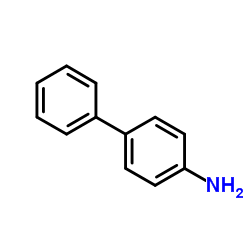4-Aminobiphenyl

4-Aminobiphenyl structure
|
Common Name | 4-Aminobiphenyl | ||
|---|---|---|---|---|
| CAS Number | 92-67-1 | Molecular Weight | 169.222 | |
| Density | 1.1±0.1 g/cm3 | Boiling Point | 302.0±0.0 °C at 760 mmHg | |
| Molecular Formula | C12H11N | Melting Point | 52-54 °C(lit.) | |
| MSDS | Chinese USA | Flash Point | 152.2±14.6 °C | |
| Symbol |


GHS07, GHS08 |
Signal Word | Danger | |
|
Toxicological assessment of kretek cigarettes: Part 1: background, assessment approach, and summary of findings.
Regul Toxicol Pharmacol 70 Suppl 1 , S2-14, (2014) This publication introduces a series of six other publications describing the toxicological assessment of kretek cigarettes, i.e., cigarettes characterized primarily by the use of a significant amount of cloves as an ingredient added to the tobacco. This pape... |
|
|
Differences between human slow N-acetyltransferase 2 alleles in levels of 4-aminobiphenyl-induced DNA adducts and mutations.
Mutat. Res. 671(1-2) , 13-9, (2009) Aromatic amines such as 4-aminobiphenyl (ABP) require biotransformation to exert their carcinogenic effects. Genetic polymorphisms in biotransformation enzymes such as N-acetyltransferase 2 (NAT2) may modify cancer risk following exposure. Nucleotide excision... |
|
|
DNA adducts of ortho-toluidine in human bladder.
Biomarkers 16(2) , 120-8, (2011) 4-Aminobiphenyl (4-ABP) and o-toluidine are known human bladder carcinogens, but only 4-ABP-releasing DNA adducts are known.Determination of 4-ABP and o-toluidine-releasing DNA adducts in epithelial and submucosal bladder tissues of sudden death victims (SDV:... |
|
|
Determination of 2,5-toluylenediamine (2,5-TDA) and aromatic amines in urine after personal application of hair dyes: kinetics and doses.
Arch. Toxicol. 85(2) , 127-33, (2011) The personal use of hair dye products is currently under discussion due to the potentially increased risk of bladder cancer among long-time users described in epidemiological literature. In order to investigate the dermal absorption of aromatic diamines as we... |
|
|
Comparison of exposure to selected cigarette smoke constituents in adult smokers and nonsmokers in a European, multicenter, observational study.
Cancer Epidemiol. Biomarkers Prev. 20(7) , 1524-36, (2011) This multicenter, observational study was conducted in three European countries (Germany, Switzerland, and the United Kingdom) to determine the exposure of adult cigarette smokers and nonsmokers to selected cigarette smoke constituents: 1,3-butadiene, 2-napht... |
|
|
Mechanisms of oxidative DNA damage induced by carcinogenic arylamines.
Front. Biosci. (Landmark Ed.) 16 , 1132-43, (2011) Most arylamines are pro-carcinogens, and require metabolic activation to yield ultimate carcinogen metabolites. O-Acetylation of the N-hydroxy form of an arylamine yields an acetoxyarylamine, which can form a highly reactive arylnitrenium ion, the ultimate me... |
|
|
Sulforaphane inhibits 4-aminobiphenyl-induced DNA damage in bladder cells and tissues.
Carcinogenesis 31 , 1999, (2010) Sulforaphane (SF) is a well-known chemopreventive phytochemical and occurs in broccoli and to a lesser extent in other cruciferous vegetables, whereas 4-aminobiphenyl (ABP) is a major human bladder carcinogen and is present at significant levels in tobacco sm... |
|
|
Reduced 4-aminobiphenyl-induced liver tumorigenicity but not DNA damage in arylamine N-acetyltransferase null mice.
Cancer Lett. 318(2) , 206-13, (2012) The aromatic amine 4-aminobiphenyl (ABP) is a liver procarcinogen in mice, requiring enzymatic bioactivation to exert its tumorigenic effect. To assess the role of arylamine N-acetyltransferase (NAT)-dependent acetylation capacity in the risk for ABP-induced ... |
|
|
4-Aminobiphenyl.
Rep. Carcinog. 12 , 38-9, (2011)
|
|
|
Unusual sequence effects on nucleotide excision repair of arylamine lesions: DNA bending/distortion as a primary recognition factor.
Nucleic Acids Res. 41(2) , 869-80, (2013) The environmental arylamine mutagens are implicated in the etiology of various sporadic human cancers. Arylamine-modified dG lesions were studied in two fully paired 11-mer duplexes with a -G*CN- sequence context, in which G* is a C8-substituted dG adduct der... |